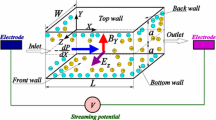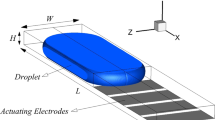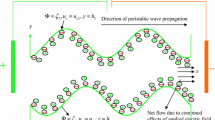Abstract
Multiphase flow control is a challenging task in microfluidic systems. Application of such ideas in electro-osmotic actuation of multiphase flows, which involves a complex convolution of phenomena ranging from electro-chemistry to hydrodynamics, is even more tricky. Most of the existing studies in the field have limited their scope to the thin electric double layer (EDL) limit, where the role of ionic space charge distribution in the EDL is simplified to provide a slip velocity boundary condition at the substrate, and the role of the fluid–fluid interface is limited to continuity of velocity and hydrodynamic shear stress. In this study, electro-osmotic flow of two immiscible fluids, an electrolytic solution and an inert gas, are studied in a rectangular microchannel and the role of interfacial potential and Maxwell stress-generated dynamics is explored in a wide range of EDL thicknesses. A net stress term is used in the transport equations which includes the electric effects by Maxwell stress as well as the hydrodynamic stress. It is observed that the free surface, depending upon its potential may enhance the fluid velocity or act as a rigid wall. With the help of two-dimensional velocity contour plots, the role of various flow parameters on flow profile is discussed. Further, a parametric analysis of flow rate gives interesting insights into the flow rate reversal and control in such microfluidic devices.






Similar content being viewed by others
References
Bhattacharyya S, Zheng Z, Conlisk AT (2005) Electro-osmotic flow in two-dimensional charged micro- and nanochannels. J Fluid Mech 540:247
Bose N, Das T, Chakraborty D, Maiti TK, Chakraborty S (2012) Enhancement of static incubation time in microfluidic cell culture platforms exploiting extended air–liquid interface. Lab Chip 12:69–73
Chang HC, Yossifon G, Demekhin EA (2012) Nanoscale electrokinetics and microvortices: how microhydrodynamics affects nanofluidic ion flux. Ann Rev Fluid Mech 44:401–426
Choi W, Sharma A, Qian S, Lim G, Joo SW (2010) Is free surface free in micro-scale electrokinetic flows? J Coll Inter Sci 347:153
Churaev NV (2000) Liquid and vapor flows in porous bodies: surface phenomena. In: Hughes R (ed) Topics in chemical engineering, vol 13. Gordon and Breach, New York
Gao Y, Wong TN, Yang C (2005a) Transient two-liquid electroosmotic flow with electric charges at the interface. Coll Surf A 266:117–128
Gao Y, Wong TN, Yang C, Ooi KT (2005b) Two-fluid electroosmotic flow in microchannels. J Coll Inter Sci 284:306–314
Griffiths SK, Nilson RH (2006) Charged species transport, separation, and dispersion in nanoscale channels: autogenous electric field-flow fractionation. Anal Chem 78:8134–8141
Lee JSH, Li D (2006) Electroosmotic flow at a liquid–air interface. Microfluid Nanofluid 2:361–365
Levin Y, Dos Santos AP, Diehl A (2009) Ions at the air–water interface: an end to a 100-year-old mystery? Phys Rev Lett 103:1–4
Lin H (2009) Electrokinetic instability in microchannel flows: a review. Mech Res Commun 36:33–38
Marmur A (2004) The lotus effect: superhydrophobicity and metastability. Langmuir 20:3517–3519
Mayur M, Amiroudine S, Lasseux D (2012) Free-surface instability in electro-osmotic flows of ultrathin liquid films. Phys Rev E 85:046301
Ozen O, Aubry N, Papageorgiou DT, Petropoulos PG (2006) Electrohydrodynamic linear stability of two immiscible fluids in channel flow. Electrochim Acta 51:5316–5323
Ramos A (2011) Electrokinetics and electrohydrodynamics in microsystems. SpringerWien, New York
Schoch RB, Han J, Renaud P (2008) Transport phenomena in nanofluidics. Rev Mod Phys 80:839–883
Author information
Authors and Affiliations
Corresponding author
Rights and permissions
About this article
Cite this article
Mayur, M., Amiroudine, S., Lasseux, D. et al. Maxwell stress-induced flow control of a free surface electro-osmotic flow in a rectangular microchannel. Microfluid Nanofluid 16, 721–728 (2014). https://doi.org/10.1007/s10404-013-1262-1
Received:
Accepted:
Published:
Issue Date:
DOI: https://doi.org/10.1007/s10404-013-1262-1




